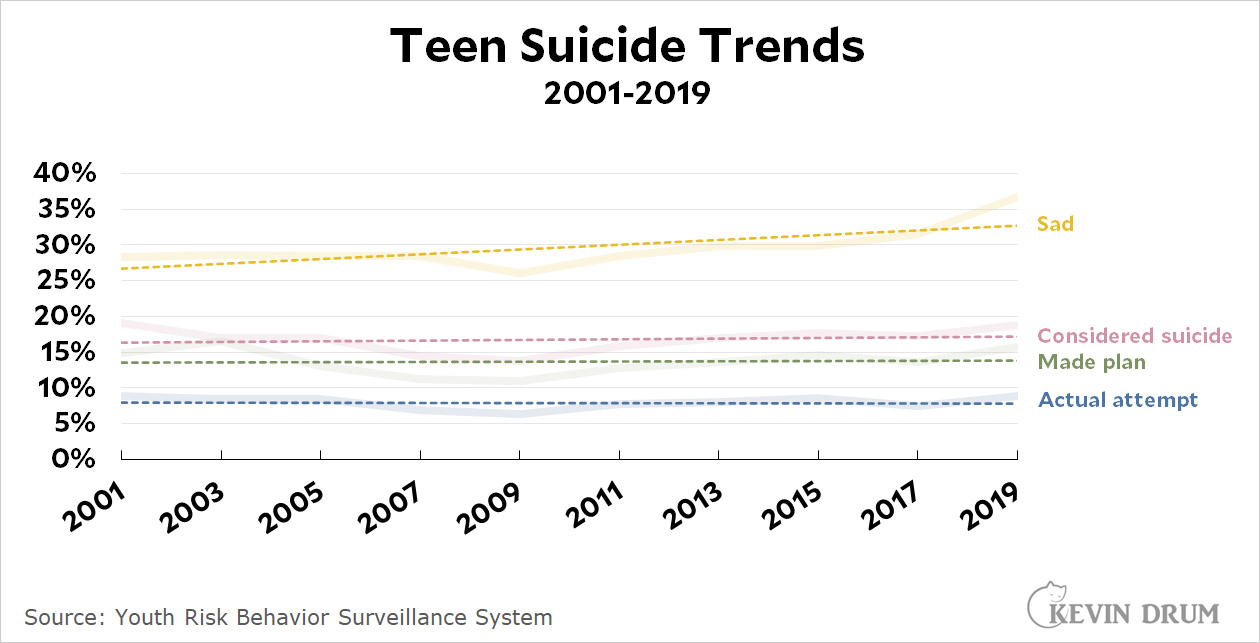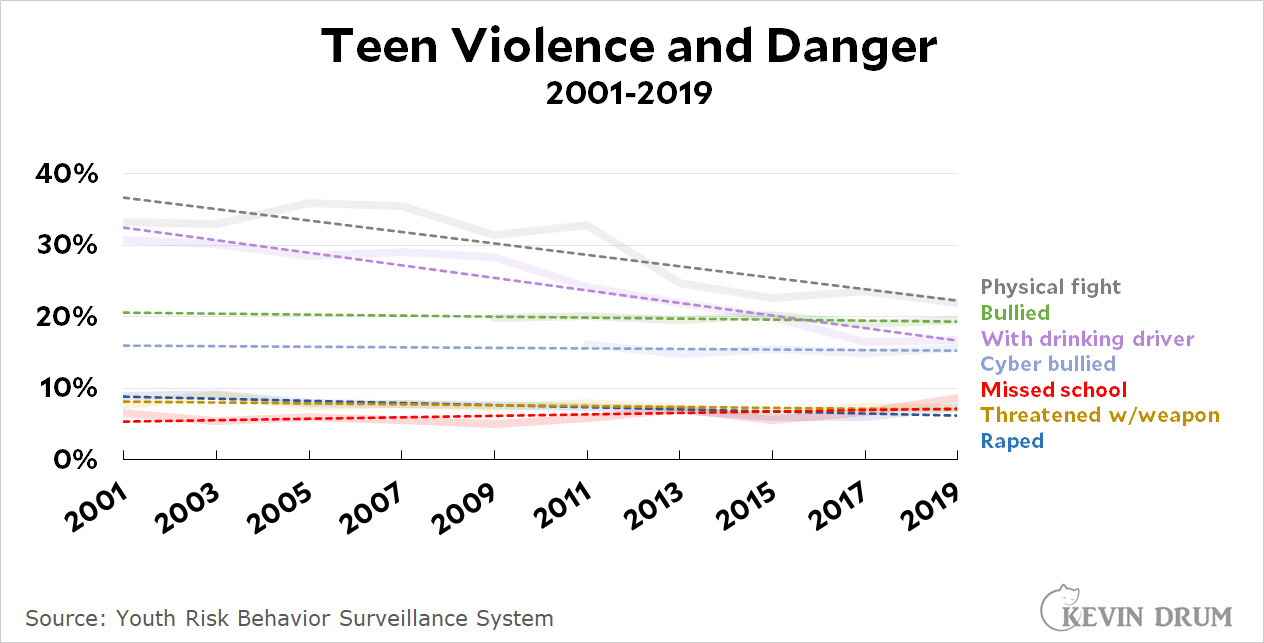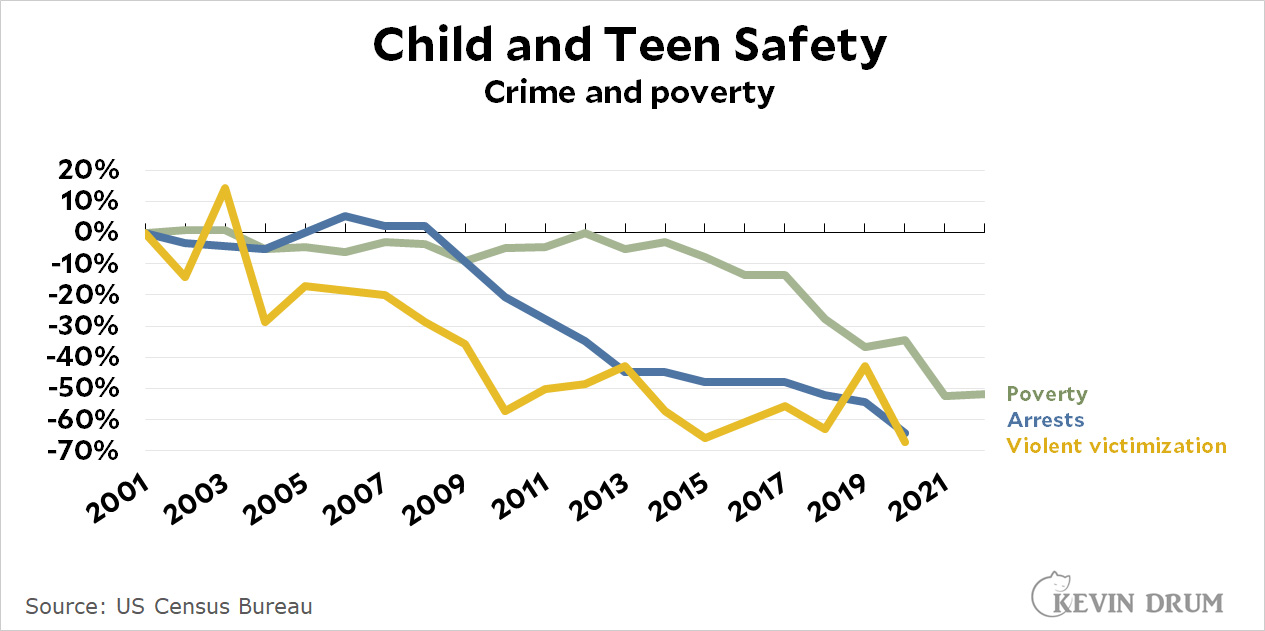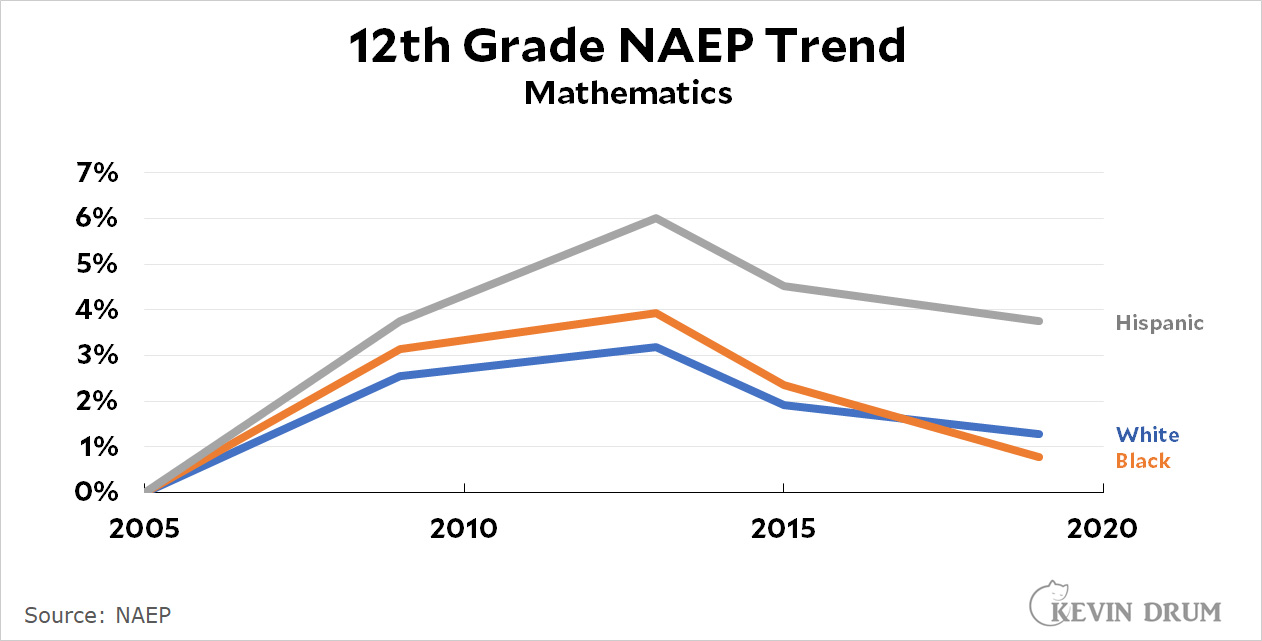Over at New York, Eric Levitz takes on a popular explanation for rising teen suicides: the world is objectively more horrible than it used to be and teens are depressed about it. Levitz presents a blizzard of statistics to show that life today isn't objectively worse than life a few decades ago, and everything he says is correct. But I want to zoom in on the past couple of decades and specifically on high school life.
Much of what follows comes from YRBSS, the Youth Risk Behavior Surveillance System run by the CDC since about 1990. You should check out the YRBSS Explorer, which was clearly designed by a person with a sense of whimsy. Stuff is presented semi-randomly as you scroll around, and it's great fun to use. But here's some serious stuff. First, teen suicide:
 Note a couple of things: teen sadness has gone up and consideration of suicide has gone up slightly. However, planned suicide and actual suicide attempts are flat over the past 20 years.
Note a couple of things: teen sadness has gone up and consideration of suicide has gone up slightly. However, planned suicide and actual suicide attempts are flat over the past 20 years.
Here is violence and danger among teens:
 Every single trend is down or flat. The only exception is a recent uptick in the number of teens who missed school because they felt unsafe there (or on the way to school). This is despite the fact that teens don't report higher levels of actual danger.
Every single trend is down or flat. The only exception is a recent uptick in the number of teens who missed school because they felt unsafe there (or on the way to school). This is despite the fact that teens don't report higher levels of actual danger.
Note especially that bullying and cyberbullying are flat. I mostly tried to stick with trends that had been tracked since 2001, but I made an exception for bullying because the results are likely to be startling to a lot of people.
Here is drug and alcohol use:
 Everything is down. Everything. And I didn't even include cigarette smoking, which is way, way down. Sex is down too—though you'll have to decide for yourself if that's a good trend or a bad one. Ditto for teen pregnancy, which almost certainly is a good trend.
Everything is down. Everything. And I didn't even include cigarette smoking, which is way, way down. Sex is down too—though you'll have to decide for yourself if that's a good trend or a bad one. Ditto for teen pregnancy, which almost certainly is a good trend.
Here are a few basic trends in teen safety:
 Again, everything is down. Way down. There are far fewer children in poverty these days; far fewer committing violent crimes; and far fewer being violently victimized. Child abuse is way down too, including sexual abuse.
Again, everything is down. Way down. There are far fewer children in poverty these days; far fewer committing violent crimes; and far fewer being violently victimized. Child abuse is way down too, including sexual abuse.
Finally, here's how they're doing in school:

 In 2005 there was a break in how NAEP assessments were done, which is why these charts start there. As you can see, things are up and down a bit, but overall they're up for everything except for recent reading scores among Black students.
In 2005 there was a break in how NAEP assessments were done, which is why these charts start there. As you can see, things are up and down a bit, but overall they're up for everything except for recent reading scores among Black students.
Most of these trends are through 2019, which is the latest data available. But that's actually useful, since it gives us a clean picture of pre-pandemic America. Not everything is perfect, and you can surely search out some negative trends if you want, but the basics of teen life simply haven't gotten worse over the past 20 years.
Needless to say, this makes some of the recent upticks in teen mood disorders even more mysterious. These predate COVID, so that's at most a partial explanation, and they postdate the adoption of social media, so that too is also no more than a partial explanation. So what are we missing?

I think what's missing is the avalanche of stories--video and written--telling teens how screwed they are, and how unhappy, and how helpless. After that constant exposure, is it surprising that the rest of us start to believe it, and thus believe that teens believe it too?
Like! Not to mention our out of control inflation and the imminent recession. Plus Joe Biden's senility.
Start making more money weekly. This is valuable part time work for everyone. The best part ,work from the comfort of your house and get paid from $10k-$20k each week . Start today and have your first cash at the end of this week. Visit this article
for more details.. https://createmaxwealth.blogspot.com
WHUT!!!!!!????
No Teen Age Sex!!!
Doesn't the media have a rolling 20 year list of topics to blather about?
Oh, yes. I've seen conservative commentators bemoan the lack of teen nooky happening because, well, they get all they want on PornHub these days. (The teens, not the conservative pundits. Presumably.)
The legacy of the 21st century in America is miserable. A stolen election (2000), an unprecedented terrorist attack (2001), political demonization (2002-2004), 2 long wars (2001-2021), torture was approved (2002-2007) economic collapse (2008), a politicial revolution that failed (2009) a backlash to change (2010), rise of local fascism (2016-Present) plague (2020-present), extreme economic instability (2020-present), open war (2022-present) and above it all the looming apocalypse of climate change with ever more dire events and never ever dealt with in a way that actually makes things better only less worse.
Also bullying may not be greater in absolute terms but qualitatively it is much much worse and now schools (as this Chronicle article shows) are ungovernable.
https://www.sfchronicle.com/bayarea/article/sfusd-middle-school-ukraine-war-teen-refugee-17775257.php
This is an excellent example of negativity bias …
I’m sorry, but to describe the 2008 recession as “economic collapse” is, frankly, a ridiculous overstatement.
Collapse might be extreme but it was the longest and deepest recession since the Great Depression, it was worldwide and took many years to fully recover from so what would you call it ?
Your average 15 year old has no idea who Al Gore or even W is, doesn't remember the Great Recession at all, barely knows anything about Barak Obama, had no clue the wars in Iraq or Afghanistan were happening for most of the time they were going on (unless a family member wss serving there), learned about 9/11 and Katrina as long ago historical events, and haven't the slightest clue what fascism is. Adults obsess over these, not 15 year olds.
Climate change? That's not new at all (those of us old enough to know who AL Gore is had dual climate change AND ozone hole worries). It seems extremely unlikely that bullying is much worse now than before.
Most of the stuff people point to is either just the same issues we've had for decades (police brutality, extreme beauty standards, sexism, violence in schools, etc), or not the kind of thing that teens spend much time thinking about (past economic recessions, global conflicts. etc). Even things like covid have similar things in the past - just ask anyone taking Sex Ed back in 1990, when AIDS was still a death sentence.
There's been plenty of crummy stuff for decades. At least today's teens don't have to worry about mass incarceration (that's way down) or get thrown off of health insurance at age 18.
Moreover, you could make the same dramatic-sounding claims about any era of US history. Look at the 60s. We had a president assassinated. And the greatest civil rights leader the country has produced assassinated. And a NY Senator assassinated. And a bloody and purposeless foreign war that was killing a thousand Americans a month at its height. And massive social tensions. And surging violent crime. And and arms race. And...
You really have no idea how much climate change worries teens do you? Wow.
Did society change as much due to aids? I was pretty young in 1990 and I remember the Linda Ellerbie specials but aside from that...? Instead for COVID everytginh shut down, schools closed s lot of people had family members go Q crazy.
Also don't underestimate politics and economics. Slouching Toward Utopua and all that. Essentially the backdrop is people generally being nastier and money being harder to come by since 2010.
“ Also bullying may not be greater in absolute terms but qualitatively it is much much worse”
Oh, that’s such utter presentist bullshit.
Because it's much easier to spread around and harder not to encounter it. You are right quality is probably not the best word. Pervasive better.
You need to read Jonathan Haidt's substack. Charts like this don't take into account the network effects of social media.
Ah, but in 2020, things changed!
"According to the Centers for Disease Control and Prevention, which provides detailed data by cause of death, the major categories of teen deaths are unintentional injuries or accidents (e.g., car crashes), homicides and suicides. While rates for all three leading causes climbed between 2014 and 2017, rates for accidents and homicides started rising in this period for the first time in years, and then both rates jumped sharply in 2020, while suicides did not. Digging into the data further, the firearm death rate for teens — and the rate of homicides due to firearms, specifically — mirrored these rises in 2014 and 2020. In fact, in 2020, firearms killed more teens ages 15 to 19 than did car accidents, which had been the specific leading cause of death for decades.
Among accidental deaths, an increasing share (30% in 2020) are due to drug overdoses and poisoning. The nation’s leading health organizations are urging policymakers and others to take further action to address the troubling rise in overdoses among teens and other age groups."
https://datacenter.kidscount.org/updates/show/299-teen-death-rates-2020#:~:text=According%20to%20the%20Centers%20for,crashes)%2C%20homicides%20and%20suicides.
Negativity bias must play some kind of role.
In the Levitz article, he mentions and sometimes discusses examples of the negativity bias prevalent in the kind of tweets, memes, and tik toks that circulate through an average kid’s social media feed.
And then of course there’s the negativity bias of news media. We cannot just take that for granted. I have long since come to the conclusion that our American news media morphed into some kind of social pathology. It’s just not psychologically safe for the population as a whole to hear nothing but the worst news presented in the most depressing manner possible. I am completely serious when I say that the negativity bias in our news may be more harmful to the public than smoking.
And then these trends start to combine: we wind up with social media apps that are designed to stoke outrage spreading the news media’s dystopian vision of the world to an ever wider audience. These factors must play a part in rising depression and suicide rates.
And the kids themselves feed off of each other’s depression. It really doesn’t help anything -at all- when people like Greta thunberg give recent interviews declaring that the world grows more grim by the day.
In regard to the timing, I generally agree that it almost certainly relates to social media, but maybe not to the introduction of social media. The rising rates of depression may relate to the timing of tweeks that were made to algorithms in order to stoke even more outrage and misery. That’s probably what we should be looking for, and I’m not even certain how public that info is …
Like +20!
Negativity sells, as does outrage. The "news" function is a profit center, not a social responsibility. And the worse it gets, the worse people feel, so ... the worse the news gets! So more folks click, tune in, read! It's a perpetual money machine!
This is how the women's fashion and "beauty" industry has always worked. Make the ladies feel bad about their appearance, and they'l buy, buy, BUY whatever products will make them "beautiful."
After writing the above post, I began to remember and think about my own experiences in the summer of 2020 (after the tragic George Floyd incident). My use of social media must be a lot less than that of younger types, but even I could notice an obvious and dramatic change in the content I was encountering. I've always hung out with Liberal types, and I live in a very Lefty city, but the radicalization of the social media posts I saw that summer was eye-popping. Everything, everywhere, all at once was suddenly all about the hellscape of an irredeemably evil and racist country we live in. I ultimately wound up blocking or unfriending anywhere from one to two dozen "friends" who simply would not let up on the constant vitriol against systemic issues. Certainly, there are problems to address, but I didn't see any constructive attempt at doing so in those social media posts.
So, what must that time have been like for Liberals and Leftys of a younger generation? How much must they have had it pounded into their heads that we're the most evil country ever in the history of forever, and that they're all permanently complicit in the sins of our wickedly malignant ancestors? How much worse was all that incessantly negative messaging for a demographic group much less likely than me to get offline or "unfriend" negative influences?
If I had lived through that as a kid, I'd probably still be on anti-depressants. Even worse, however, is this: what did any of that online noise actually accomplish? The defund-the-police movement may have done little or nothing more than counter-productively help a lot of Republicans get elected in the fall of 2020. It's one thing to go through merciless suffering, but it's another thing when all of that protest and turmoil actually manages to simply make things worse.
I think it's suggesting that people are better parents than they used to be.
When I was in high school in the 70s it all seemed like it was essentially junior league Clockwork Orange, but it doesn't seem like that now. The atmosphere I remember was so terrible it actually felt like there could be a mass shooting at any moment but it never happened, and now it seems that, to an outside observer, teenage school life is so incredibly better than it was then there is perversely an actual real chance it could happen.
This may have to do with the uptick in sadness, as teens may feel they're being over-controlled and over-managed, and, though protected, they're alarmed by what they don't know about that they may have to be protected from and finding that in the news every day, and the seemingly immediate threat of being shot by a lunatic in a massacre.
Measurement error.
Its actually not mysterious. After generations where each generation tried like crazy to assert that they were different from their elders, only to find out that things were pretty much the same, enter the internet and smart phones.
No other generation born prior to the 1990s ever had an imaginary world every bit the equal to the actual world. Television is sort of, maybe, close, but not comparable.
So, is it surprising that every trend which required interaction with the actual physical world is down? Of course its down. There are only so many hours in a week. If kids today have 30 or so of those hours spent in interactive internet screentime, that's 30 fewer hours for drugs, sex, whatever else.
The real drug was the virtual, pixilated pablum peddled by pontificating palavers of electronic propriety.
Seriously, I think you hit something - almost a replacement for all those behaviors with a nicotine like addictive quality.
Drug use down, alcohol down, sex down, youth sports participation down.....sadness up.
Hmmm....i have no idea what order to put these in, but i feel like we have all the pieces of the puzzle.
Stuffed crust pizza and taco tuesdays might be the last seams holding things together.
Inverse correlation but perhaps a kernel of truth. Drugs, sex, and sports were things that provided a purposeful life for the contemporaries in my youth. Kids today have no reason to live outside the digital environment.
Got a chart for the dates of introduction and prescribing rates for mood disorder medications?
I read this today:
Chris Rock says teachers provide half of the education at school, bullies provide the other. “And learning how to deal with bullies is that half you’ll actually use as a grownup.”
That's not a defense of bullying. But if bullies -- or assholes, in general -- are a constant (I suspect they are), then learning to deal with them is a valuable skill. Often, the best strategy is to ignore them. But our media and social media are addicted to them, giving the assholes the attention they crave. Instead, let's learn to walk away. Let's stop covering them, normalizing them, and (especially) electing them to office.
The upwards trend for sadness and suicidal behavior seems to correspond with about the time that Kevin started saying that AI would take everyone’s jobs leaving them with no way of earning a living. They don’t believe there is any way this will work out for them and see the likelihood of a very bleak future.
So it’s all Kevin’s fault.
"So it’s all Kevin’s fault."
You've hit the nail on the head. Kevin keeps saying self-driving cars are coming any day now and that's one big reason teens today are so nonchalant about getting their drivers' licenses. If they only understood how wrong Kevin is about that, they'd get their licenses on their 16th birthday like they're supposed to.
Not enough sex and drugs?
I know this might not be so obvious, but has anyone actually tried asking the kids why they're depressed? It doesn't matter what the numbers say about how child poverty is down, safety is up, etc. It's about *their* perception of what is wrong. And maybe, just maybe we should listen to what they have to say?
People of my generation aren't having children at a rate high enough to cause population growth in this country. When polled my generation state we either can't afford them or we fear what the world will be like when they grow up. We're told over and over again from Kevin's charts that Millennials are doing just fine economically despite what we can see with our own two eyes, but when most of us cite economical reasons as to why we're not having children it's disregarded. Generation Alpha are for the most part children of Millennials, so maybe they're seeing the world as being as lousy as we do?
The articles I've seen that ask teens don't provide much insight, because what the teens talk about is either social media or the same crap teenage girls have had to deal with for ages. Sexism and beauty standards loom large, but those weren't invented in 2015.
People of my generation aren't having children at a rate high enough to cause population growth in this country.
That's true of all high income countries today, and even many middle income countries like Brazil and China. The economics of having children aren't favorable. Basically, high income countries that are growing robustly are those that enjoy significant immigration inflows.
We really need to talk about how you draw your trend lines.
What does Eve think? I have nothing to add….except- Folks were down right crazy when I was growing up. However, ignorance was bliss.
I think the interpretation by teens that we are living in a bleak post-community dystopian virtual society is largely correct. It is now almost impossible not to realize that we are rapidly approaching the Singularity. How exactly could we calm fears of reaching essentially infinite technological changes. Even the best futurists have no crystal ball to offer suggestions on how we will navigate through it. Of note, the Singularity might now only be 20 years away.
In the runup to this Singularity we can already see glimpses of the technological power that is approaching. ChatGPT arrived on scene only a few months ago and it already appears to have the ability to displace humans as the keepers of the knowledge of our civilization. ChatGPT could easily morph into an infinitely informed companion that could become the preferred friend of the future. How would that not be alarming to teens especially teen girls?
The polygenic revolution could also spark a Singularity like event. The polygenic genome has been cracked and we now know that tens of standard deviations of intelligence, other cognitive features, etc. are achievable with genetic engineering. How would you feel if you knew that your children would have to compete with younger children with 800 IQs? We are entering into a highly disturbing future in which everyone born before the uplift will have no economic relevance. Would you really want to have children who could never support themselves and would have to be on welfare for life? The problem is that this possibility continues to loom over this generation. A great deal of effort has went into trying to conceal the truth and yet it only prolongs and worsens the end result. When fertility reaches 0 we will know that the transition has finally arrived.
Given the above comment I am pessimistic about the future? Not at all! I am extremely optimistic! The above is Door #1. Choose a future that rejects technology, rejects a better life for the people and that is where you wind up.
Door #2 is embracing the existing technology -- people use genetic technology to their advantage. The future is then fantastic. I have studied my full genome very very carefully, I have quite a number of serious genetic disadvantages. Yet, in a single generation all of these disadvantages could be selected against, then all of my substantial genetic advantages could help the next generation of my family.
This magical future is available to all if they so desired. Doom and gloom help to clarify the consequences of choosing the wrong door. The technology already exists to bring us to a much better tomorrow. Surprisingly, today's young people are stuck at the doom and gloom stage even when they will be the parents of the first generation of genetically engineered children.
When "Die Leiden des Jungen Werther" (in which the hero commits suicide after losing his beloved to a rival) came out suicides skyrocketed with no underlying change in people's lives. I am quoting this because such a trend can have origins in popular culture. I know nothing of present day teen culture but it would be the place I'd go looking.
Pingback: Forget malaise. It’s baseless fear that engulfs society these days. – Kevin Drum
It is a bit late to comment, but I think part of the problem is a statistical error. We do not know the probability distribution of these indexes. Suicide rates are presumably associated with the extreme tail of these distributions, and the means don't tell us very much about the tails, and even less since we don't know the shape of the distribution or how it may have changed over time.
The average case may not have changed much, while extreme cases (i.e., those leading to suicide) may be getting more frequent or severe. We need to know more about the mental state of the extreme cases.